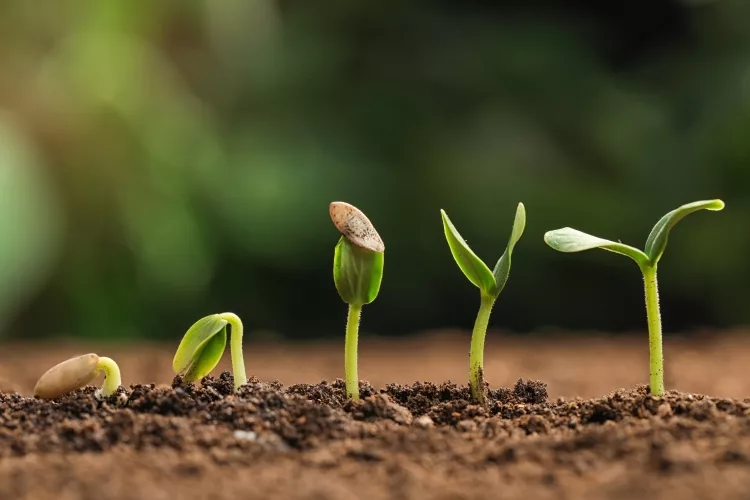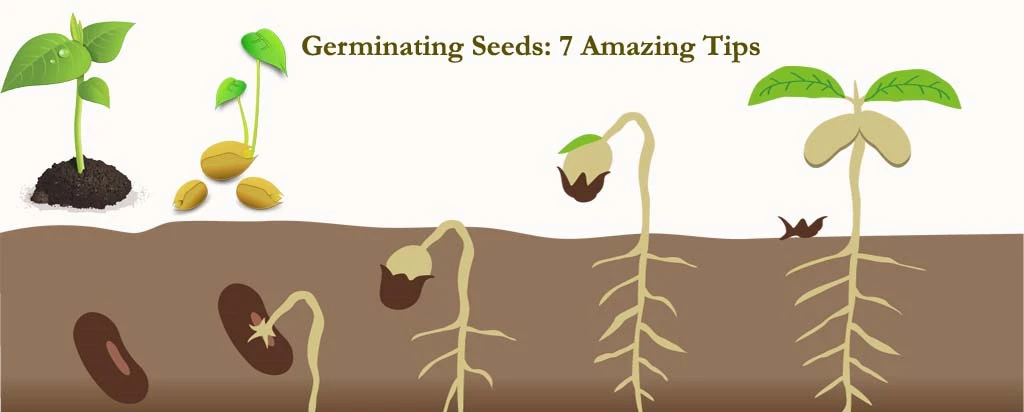reviewed by Truman Perkins
Are you popping seeds in the soil and hoping for the best when it comes to planting? Wondering why some of your sources are coming up quickly, others slowly, and some failing altogether? Germinating seeds indoors is easy, but it takes some concrete steps to get the best results.
It can be very frustrating when you have waited for weeks and have nothing to show for it. I have been there too. Learning these excellent tips will set you up to succeed in growing plants from seed.
You will be surprised that with a few changes, you will be able to germinate seeds quickly.
Contents

Many variables affect seed germination. The type of plant you intend to grow. Seed depth. Light Requirements for germination. The soil, heat, and water requirements, to name a few more.
The fantastic thing is that most should come with an operator's manual -the seed package.
The seed package is a valuable resource to use. Each plant has different needs, and they are detailed in the planting instructions. When planting instruction is missing, the internet can be a backup source. Sites like this one and others can give you the information you lack.
Besides, the seed package will give you special instructions for specific seeds. Some seeds require extra steps to get them to germinate. Neglecting these steps will fail!
Example of Special Needs for some Seeds:
This is helpful for many larger-type seeds. This softens the seed coat and prepares them for easier germination. I will often soak seeds overnight even if not indicated, not tiny seeds, but large type seeds.
This is mimicking a natural process such as the seasons to stimulate a seed to grow. Often you will need to introduce them to a period of cold moisture that they would experience in winter. Refrigeration is often the easiest way.
Tough coated seeds will often require cutting or clipping to allow them to germinate. In some circumstances, this scarification involves a specific soaking method as well.
〉〉〉 A tip on Planting time. Planning your inside garden, you can plant your seeds any time of year. You do not need to follow the recommended planting dates. That is only when moving them to an outdoor garden.
→ Now you have read any specific planting instructions. The next step - Viability!

A seed's viability is a seed's ability to germinate when presented with the proper growing conditions. You could plant a thousand seeds, but nothing may grow if they are "bad," unviable.
Doing a viability test can help you determine if the seeds you want to plant are still good. Improper storage, outdated or poorly harvested roots can be unusable for replanting.
Also, testing can determine an overall measure of the germination rate. Typically, a test is conducted with ten seeds. As an example, if a completed test shows 5 of those seeds germinated. That equals a result of a 50% germination rate. Using that as an example, that is a low rate.
This type of result would help you when planning your planting. Planting seeds with a 50% germination rate, you would want to place at least 3 to 5 seeds in each planting cell. This would raise your chance of successfully growing a plant.
Test Viability- Paper towel method
〉〉〉〉 Tip: Can you plant the germinated seeds in the paper towel? Sure. A lot of people do it. I find they do not tend to be the healthiest plants but, in many cases, can be successful. Avoid planting any germinated seed that grew too much top growth, long stem. It will be far too weak.
→ Now you know if your seeds are viable and the germination rate from your test. The next step is - The suitable soil!
Unique seed starting mixes are available on the market specifically for your needs. Many are very good at what they are designed to do. Some, ugh, maybe not so much. I gave up on buying the brands labeled "seed starting" several years ago.
I found that the ones that did the job were overpriced for such short-term use I could not justify it. Secondly, the ones lower in price lacked any value to my seedlings and often led to failures.
You Have Options
If you are going with a pre-mixed seed, starting a brand. Go with the one that has excellent reviews. Make a better investment with a higher-grade product. Reuse what you can after germination by learning how to sterilize your soil. How to Sterilize Soil For Planting.
This is a perfect method I adapted and used for years. I still use it for some seeds today, although I have recently changed. Here are three recipes to choose from.
Premium Homemade Blend - Best Mix
3 parts Coco coir (coir is preferable if you can get it)
2 Parts premium Worm Castings (vermicompost) - I use Simple Grow
1 part perlite
1/2 part greensand
Good blend! Easy and Universal
1 Parts premium Worm Castings (vermicompost) - I use Simple Grow
2 parts Green Sand/ horticulture sand or Builders Sand
Quick Mix in a Pinch - OK
1 Part Good Nutrient Rich Potting Soil. (should have Peat, perlite, and compost as main ingredients)
1 Part Green Sand/ horticulture sand or Builders Sand
*A Part can be anything. If you use an old coffee can, 1 Part is a whole can, ½ part is half the can as an example.
The Important part about these mixes is light, airy, and no sizeable organic matter pieces. The seedling will be tiny and struggle to break the surface of the soil. Large amounts of bark or other organic matter in your soil can create barriers for your emerging seed.
Here is a review of the Simple Grow worm castings that I recommend. They make excellent fertilizer throughout the growth of your plant as well.
Also, the soil that I use most frequently can be used in the final mix. Fox Farm makes great soil when you are ready for transplanting your new seedlings as well. View the review here.
Last year I fell in love with this method. I germinate many seeds, so I still use my mix, but this is my adopted MOST AWESOME way.
It started with the Park Seed Germination Dome and its bio sponges. I will be adding a review for this later. I was in awe of the germination rate and time. It was also cleaner and more efficient to transplant.
As a hydroponic grower as well, I was then introduced to Rapid Rooters. Another sponge material is made of primary peat and enriched with nutrients. They sent my seeds and their recent growth into a supercharged mood.
The best part is that both the bio sponge and the rapid rooters transplant into soil or hydroponics. Since I do both types of growing, these make perfect sense for me. Plus, the results are outstanding for root and plant growth in a short amount of time.
This is the root and plant growth of 7-week-old chives on transplant day in Rapid Rooters. They speak for themselves, impressive! A review is coming up in the next day or two!
If you do not wait for the reviews, you can follow the links below. ⇓
→ Now your base is set for success. Let's heat things!
Seed germination temperature can be very important for some plants even to begin to grow. Basil and Peppers are just two common examples of seeds that need an extra dose of heat. Without this heat, they may fail to germinate at all or take forever to do so.
Even seeds that say the heat is not required for germination can benefit from it. Heat imitates spring to give them a leap into life. Raising the soil temperature can also soften the seed coat allowing your new plant to emerge.
You may have ways right there now at home to produce heat, or you can supplement it if you don't
Ways to get heat
⇒ Ambient heat from a warm sunny window. This may be enough for some plants to get them heated up. If you still have winter weather or cool nights, watch for those chilly nights!
⇒ Top of Standing Freezers or Refrigerators. Some appliances like these put off a bit of heat above. It can sometimes be enough to generate heat into your planting medium.
⇒ Seedling Heat Mats. They make a wise investment if you plan on growing many plants. For example, I wrote a complete set review that includes the heat mat, tray, and greenhouse dome. It can give you some more ideas on how these mats work-hydrofarm germination station review.
→ Your seeds are feeling toasting and warm - how about the proper humidity?
These are tips for germinating seeds indoors Quickly. As part of that quick process, I highly recommend creating a greenhouse. Yes, it does increase the risks of potential mold and fungus issues. But, if you use proper water techniques and make venting, those risks are minimal.
A pre-vented dome is easiest. Simple set it over the seedling trays and crack the vents slightly to allow for airflow.
You can also create domes from recyclable plastic containers. The produce section of the grocery store often sells salad or other produce invented plastic trays. The bottoms make perfect domes for the greenhouse effect.
The plastic wrap will work as a third, OK option. This method is a little trickier to vent. Use plant markers, popsicle sticks, or plastic straws to create small posts in your tray. This will hold the wrap slightly off the soil surface, allowing you to cut slits in higher areas for venting.
Important! When using plastic wrap, remove it immediately when the seedlings have emerged from the soil. Domes and covers can remain longer but should never touch the plant growth. When plants reach the crowns, they need to be removed. Sooner if any fungus or mold becomes present. You can remove them as quickly as seed leaves spread out.
→ Your maintaining good humidity and moisture levels but are you properly watering?
I am going to stress water from below for seed germination! This is the best course of action when it comes to watering your baby plants.
Top watering can disturb and even sometimes harm the tender growth of your seed. Worse yet, you can easily wash tiny seeds away.
Decreased amounts of maximum moisture result in less risk of mold, fungus, and dampening of disease. This is a disease caused by a fungus that happens in damp conditions. Most often affecting young seedlings and causing death.
Stronger roots! Bottom watering will grow stronger roots as they search downwards for water, as nature intended.
Go back and look at the picture from the sponges. Those are watered bottom roots. Strong and healthy!
In an empty flat or tub that is large enough to hold your seedling trays or pots. Feel the weight of your dry seedling trays so you can gauge later.
Keep your seedlings evenly moist during germination and growth. Not swampy and over-saturated. Your domes should help with the amount of time your seeds need water.
→ Proper moisture levels are met. Now the Sun!
Most, but not all, seeds require light for germination. This goes back to check your package. Once seedlings emerge, they have different light requirements as well.
Almost all your plants will need some light once they begin to grow, whether herbs, flowers, vegetables, or house plants.
Natural lighting is perfect if you have it! A bright west or southwest window should be ideal for your seeds. You should be receiving at minimum 6 hours of light for most herbs-8 to 10 hours for other plants.
"Leggy seedlings" and plants will result if you are not providing enough light. This refers to a condition where your plant's stems are thin and weak. Often, they are bending, usually towards a source of light.
You may need to duplicate natural sunlight as best you can with grow lights. In the past, these options could prove to be expensive and power-hungry. That has changed a lot since I started using them.
Look for the most straightforward options that fit your garden space and adapt to what you intend to grow now and in the future. That will help you get the most return on your investment.
I have 2 Articles on Site to help "illuminate" lighting options when natural light is not there. The first here will provide you with more information about grow lights in general. The second article dives into the Best LED grow lights, a mighty low power consuming option.
Taking these steps will help you germinate seeds indoors quickly. However, there will always be exceptions. Certain seeds, by nature, are rigid and slow to grow. You can follow these steps to ensure success, but you will still need to cultivate a bit of patience.
For those hard to germinate seeds, experiment a little. Try pre-soaking or scarification to loosen seed coats. In your viability test, note how long it takes to grow. This can help you anticipate the timing better.
Not Seeds, but let's talk roots. For Rhizomes, root planting, soak the roots overnight in warm water. This will aid them in taking root in their newly planted soil.
Do you have a seed type that has been tough for you to germinate? I have found rosemary and lavender were problematic until I started following these steps. Let me know your experiences below. Also, if you have any questions or anything I can help with, reach out! Here to help!
Happy Germinating!
 |
 |
 |
 |

About Truman Perkins
Truman Perkins is a Detroit-based SEO consultant who's been in the business for over a decade. He got his start helping friends and clients get their websites off the ground, and he continues to do so today. In his free time, Truman enjoys learning and writing about gardening - something he believes is a natural stress reliever. He lives with his wife, Jenny, and their twins in Detroit.
 |
 |
 |
 |
Get new FREE Gifts. Or latest free growing e-books from our latest works.
Disable Ad block to reveal all the links. Once done, hit a button below
 |
 |
 |
 |